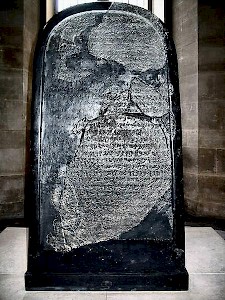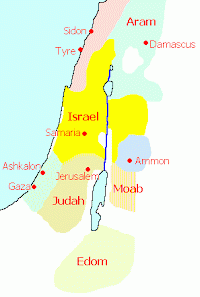The Stela of Mesha
The Stela of Mesha: building inscription from ancient Moab, famous because it describes events from the history of Israel that are also described in the Bible.

In the first half of the ninth century BCE, Israel was a mighty kingdom. Its king Omri (884-873) owned at least two thousand chariots and even king Šalmaneser of Assyria admitted that Israel was a powerful enemy. Omri's son Ahab (873-852) brought the kingdom to even greater prominence.
However, king Hazael of Aram-Damascus defeated Ahab's son Jehoram, and a general named Jehu overthrew the dynasty of Omri. There is archaeological evidence that part of the kingdom's heartland was even occupied by Aramaean troops. At the same time, Moab, a vassal state of Israel, broke away from Israelite overlordship. Israel's fortunes were restored when the Assyrians attacked Aram-Damascus in 842, but Moab was lost.

The story is told in the Bible,note and was more or less confirmed by a Moabite inscription that was discovered by a German missionary in 1868 in Dhiban, the ancient Moabite capital Dibon. It records the building of Karchoh, which appears to have been a fortified quarter in the city. This was not without importance, because in the nineteenth century, many scholars had started to doubt the reliability of the Bible as source for ancient history. The stela in which king Mesha offers his view on the war against Israel was seen as an important argument against these skeptics.
To some extent, the inscription offers few surprises. The author of 2 Kings claims considerable Israelite successes; the Moabite king Mesha makes the same claim. His victory, he says, is the result of support from the national god Kemoš, which was not a strange theological idea. The inscription also contained a reference to YHWH; until now, this is the earliest occurrence of the name of the god in an inscription.
The Biblical tribe of Gad is also mentioned, but it is obvious that Mesha was unaware of a tradition in which Gad was regarded as one of the twelve tribes that had migrated to Canaan. Another difference between the account in the Bible and the story on the stela is that in 2 Kings, Mesha's opponent is Omri's grandson Jehoram, whereas the inscription speaks of a of Omri. This can, however, simply be explained, as the word "son" often meant "descendant".
After the French scholar Charles Clermont-Ganneau had made squeezes, the Arabs living in Dhiban destroyed the stela, which was about 1.24 meters high and 71 centimeters wide, because they believed that the black basalt stone had magic properties and could serve well as talisman to protect granaries. The fragments were recovered, however, and are now on display in the Louvre museum, in Paris; the dimensions now are 1.15 x 0.60 meters.
The translation of the stela offered below is based on the surviving remains and Clermont-Ganneau's squeeze, and was adapted from a version by Klaas Smelik. The language closely resembles Hebrew.
[1] I am Mesha, the son of Kemoš-yatti, the king of Moab, from Dibon. My father was king over Moab for thirty years, and I was king after my father.
[2] And in Karchoh I made this high place for Kemoš [...] because he has delivered me from all kings, and because he has made me look down on all my enemies.
[3] Omri was the king of Israel, and he oppressed Moab for many days, for Kemoš was angry with his land. And his son succeeded him, and he said - he too - "I will oppress Moab!" In my days he did so, but I looked down on him and on his house, and Israel has gone to ruin, yes, it has gone to ruin for ever!
[4] Omri had taken possession of the whole land of Medeba and he lived there in his days and half the days of his son, forty years, but Kemoš restored it in my days. And I built Ba'al Meon, and I made in it a water reservoir, and I built Kiriathaim.
[6] And the men of Gad lived in the land of Ataroth from ancient times, and the king of Israel built Ataroth for himself, and I fought against the city, and I captured, and I killed all the people from the city as a sacrifice for Kemoš and for Moab, and I brought back the fire-hearth of his Uncle from there, and I hauled it before the face of Kemoš in Kerioth, and I made the men of Sharon live there, as well as the men of Maharith.
[7] And Kemoš said to me: "Go, take Nebo from Israel!" And I went in the night, and I fought against it from the break of dawn until noon, and I took it, and I killed its whole population, seven thousand male citizens and aliens, female citizens and aliens, and servant girls; for I had put it to the ban of Aštar Kemoš. And from there, I took the vessels of YHWH, and I hauled them before the face of Kemoš.
[8] And the king of Israel had built Jahaz, and he stayed there during his campaigns against me, and Kemoš drove him away before my face, and I took two hundred men from Moab, all its division, and I led it up to Jahaz. And I have taken it in order to add it to Dibon.
[9] I have built Karchoh, the wall of the woods and the wall of the citadel, and I have built its gates, and I have built its towers, and I have built the house of the king, and I have made the double reservoir for the spring, in the innermost of the city. Now, there was no cistern in the innermost of the city, in Karchoh, and I said to all the people: "Make, each one of you, a cistern in his house." And I cut out the moat for Karchoh by means of prisoners from Israel.
[10] I have built Aroer, and I made the military road in the Arnon. I have built Beth Bamoth, for it had been destroyed. I have built Bezer, for it lay in ruins.
[11] And the men of Dibon stood in battle-order, for all Dibon, they were in subjection. And I am the king over hundreds in the towns which I have added to the land.
[12] And I have built the House of Medeba and the House of Diblathaim, and the House of Ba'al Meon, and I brought there [...] the flocks of the land.
[13] And Horonaim, the House of David lived in it. And Kemoš said to me: "Go down, fight against Horonaim!" I went down [...] and Kemoš restored it in my days. And [...] from there [...]
[14] And I [...]